复旦大学医学院历年考博真题汇总
同济、协和、首医、中山、复旦部分考搏试题
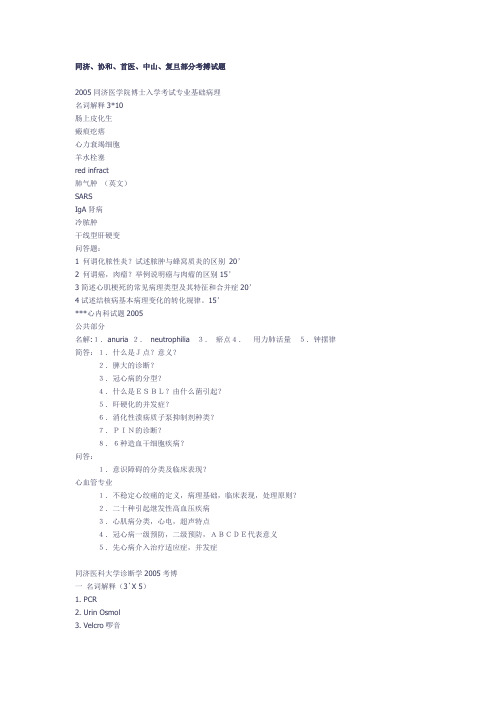
同济、协和、首医、中山、复旦部分考搏试题2005同济医学院博士入学考试专业基础病理名词解释3*10肠上皮化生瘢痕疙瘩心力衰竭细胞羊水栓塞red infract肺气肿(英文)SARSIgA肾病冷脓肿干线型肝硬变问答题:1 何谓化脓性炎?试述脓肿与蜂窝质炎的区别20’2 何谓癌,肉瘤?举例说明癌与肉瘤的区别15’3简述心肌梗死的常见病理类型及其特征和合并症20’4试述结核病基本病理变化的转化规律。
15’***心内科试题2005公共部分名解:1.anuria 2.neutrophilia3.瘀点4.用力肺活量5.钟摆律简答:1.什么是J点?意义?2.脾大的诊断?3.冠心病的分型?4.什么是ESBL?由什么菌引起?5.旰硬化的并发症?6.消化性溃疡质子泵抑制剂种类?7.PIN的诊断?8.6种造血干细胞疾病?问答:1.意识障碍的分类及临床表现?心血管专业1.不稳定心绞痛的定义,病理基础,临床表现,处理原则?2.二十种引起继发性高血压疾病3.心肌病分类,心电,超声特点4.冠心病一级预防,二级预防,ABCDE代表意义5.先心病介入治疗适应症,并发症同济医科大学诊断学2005考博一名词解释(3`X 5)1. PCR2. Urin Osmol3. Velcro啰音4. S2固定分裂音5. Standard bicarbonate二问答题1. 不同情况下腹壁静脉曲张的方向及辨别腹壁静脉曲张来源的方法。
2. 舒张期奔马律的听诊特点及其与生理性第三心音的区别。
3. 急性前壁心梗心电图的演变过程及特征。
4. 病理反射的概念及内容。
5. LDL致AS的机制。
6. 女,30岁,发热咳嗽、关节痛一个月。
体检:38度,双面部蝶形红色皮疹,双肺呼吸音减弱,胸片示双侧胸腔积液,尿Pro +++,管型尿。
1)最可能的诊断2)为明确诊断首选实验室检查3)假设诊断成立,对诊断最具价值的实验室结果。
7. 男,27岁,厌油伴乏力,纳差,皮肤黄染一周,伴黑便尿少,意识障碍两天。
复旦大学医学部博士入学考试内科试题

复旦大学医学部博士入学考试内科试题(历年真题)
复旦大学医学部博士入学考试内科试题(第一套)
1.肝性脑病的发病机制和治疗
2.确诊肺癌后,应如何决定治疗方案,如何考核疗效
DA型糖尿病的临床特点与2型糖尿病的鉴别
4.预激伴室上速的治疗
5.造血干细胞移植的定义分类、应用和发展方向
6.糖尿病肾病的发病机制和治疗
复旦大学医学部博士入学考试内科试题(第二套)1、COPD 的定义演变及其治疗进展
2、慢性心力衰竭的治疗进展
3、原发性胆汁性肝硬化的发病机理及治疗
4、肾移植的内科处理
5、糖尿病的口服药物的治疗
6、MDS、D二聚体
复旦大学医学部博士入学考试内科试题(第三套)
1、自发性腹膜炎的定义、发病机理,诊断标准,哪些病人需预防性使用抗生素。
2、急性冠脉综合征的定义,治疗原则
3 肺癌的诊断技术及进展,如何选择合理利用。
3、甲亢的临床类型,Graves病的发病机理。
4、肾性贫血的原因,是否需要补铁,为什么?
5、血液恶性肿瘤的治疗中,针对蛋白分子靶向治疗进展,。
(完整word版)复旦大学博士研究生入学考试试题及答案详解

复旦大学2003年博士研究生入学考试试题Part Ⅰ(略)Part ⅡDirections: There are 20 incomplete sentences in this part. For each sentence there are four choices marked A, B, C and D. Choose the ONE that best completes the sentence. Then mark the21. SheA. missedB. budgetedC. loathed22. They tried to keep it quiet but eventually everyone learned about theA. intangibleB. sedateC. impudent23. Many citizens appealed to the city government for enacting laws to protect theA. rigorousB. equivocalC. stringent24. People who like to wear red clothes are more likely to be talkative andA. lucrativeB. introvertedC. vivacious25. This is but a of the total amountA. frictionB. fractionC. faction26. They were tired, but not any less enthusiasticA. onB. byC. for27. I think it is high time we the fact that environmental pollution in this area isA. woke up toB. must wake up toC. wake up to28. So was the mood of the meeting that an agreement was sA. resentfulB. amiableC. suffocating29. Rescue workers continued the delicate task of sifting through tons of concrete andA. scrapsB. leftoversC. debris30. When sheA. came toB. came offC. came through31. The shortage of water became more this summer with the highest temperatures in 40 yeaA. needyB. latentC. uneasy32. They tried to drive their horse into the river, but he simply couldA. budgeB. surgeC. trudge33. Even the best medical treatment can not cure all the diseases that men andA. beseechB. besetC. bewitch34. The boy's talent might have lain had it not been for his uncle'sA. extinguishedB. dormantC. malignantD.35. The two leaders made a show of unity at the press conference, though they had notablyA. discontinuousB. discreetC. discordant36. Jack admitted that he ought not to have made his mother angry,A. oughtn't heB. wasn't heC. didn't he37. An old woman was badly hurt in the police describe as an apparently motivelessA. thatB. whichC. what38. As the city has become increasingly and polluted, there has been a growingA. flourishedB. boostedC. congested39. The taxi in front of a girl, just in time to avoidA. turned inB. pulled upC. cleared up40. The doctor told him to be careful when taking sleeping pills because too manyA. lethalB. vitalC. wholesomeD. sanitaryPart ⅢDirections: There are 4 reading passages in this pall. Each passage is followed by some questions or unfinished statements. For each of them there are four choices marked A, B, C and D. Choose the best answer and mark the corresponding letter on the Answer Sheet with a single lineFor my proposed journey, the first priority was clearly to start learning Arabic. I have never been a linguist. Though I had traveled widely as a journalist, I had never managed to pick up more than a smattering of phrases in any tongue other than French, and even my French, was laborious for want of lengthy practice. The prospect of tackling one of the notoriously difficult languages at the age of forty, and trying to speak it well, both deterred and excited me. It was perhaps expecting a little too much of a curiously unreceptive part of myself, yet the possibility that I might gain access to a completely alien culture and tradition by this means was enormouI enrolled as a pupil in a small school in the center of the city. It was run by a Mr Beheit, of dapper appearance and explosive temperament, who assured me that after three months of his special treatment I would speak Arabic fluently. Whereupon he drew from his desk a postcard which an old pupil had sent him from somewhere in the Middle East, expressing great gratitude and reporting the astonishment of local Arabs that he could converse with them like a native. It was written in English. Mr Beheit himself spent most of his time coaching businessmen in French, and through the thin, partitioned walls of his school one could hear him bellowing in exasperation at some confused entrepreneur:“Non, M. Jones. Jane suis pas francais. Pas, Pas, Pas!” (No Mr. Jones, I'm NOT French, I'm not, not, NOT!). I was gratified that my own tutor, whose name wasFor a couple of hours every morning we would face each other across a small table, while we discussed in meticulous detail the colour scheme of the tiny cubicle, the events in the street below and, once a week, the hair-raising progress of a window-cleaner across the wall of the building opposite. In between, bearing in mind the particular interest I had in acquiring Arabic, I would inquire the way to some imaginary oasis, anxiously demand fodder and water for my camels,wonder politely whether the sheikh was prepared to grant me audience now. It was all hard going.I frequently despaired of ever becoming anything like a fluent speaker, though Ahmed assured me that my pronunciation was above average for a Westemer. This, I suspected, was partly flattery, for there are a couple of Arabic sounds which not even a gift for mimicry allowed me to grasp for ages. There were, moreover, vast distinctions of meaning conveyed by subtle sound shifts rarely employed in English. And for me the problem was increased by the need to assimilate a vocabulary, that would vary from place to place across five essentially Arabic-speaking countries that practiced vernaculars of their own: so that the word for “people”, for instance, might be nais,Each day I was mentally exhausted by the strain of a morning in school, followed by an afternoon struggling at home with a tape recorder. Yet there was relief in the most elementary forms of understanding and progress. When merely got the drift of a torrent which Ahmed had just released, I was childishly elated. When I managed to roll a complete sentence off my tongue without apparently thinking what I was saying, and it came out right, I beamed like an idiot. And the enjoyment of reading and writing the flowing Arabic script was something that did not leave me once I had mastered it. By the end of June, no-one could have described me as anything like a fluent speaker of Arabic. I was approximately in the position of a fifteen-year old who, equipped with a modicum of schoolroom French, nervously awaits his first trip to Paris. But this was something I could reprove upon in my own time. I bade farewell to Mr Beheit, still struggling toB. He was vol42. It is known from the passage that the writerB. couldn't mak43. It can be inferred from the passage that Ahmed wasC. a44. The word “modicum” in the last paragraph can be replaced by45. Which of the following statements is FALSE according to theC. The writer found learning Arabic was a grueling experience but rewD. The writer regarded Ahmed's praise of his pronunciation as tongue-in-It is one of the world's most recognized phrases, one you might even heat in places where little English is spoken:‘The name's Bond, James Bond.’ I've heard it from a taxi driver in Ghana and a street sweeper in Paris, and I remember the thrill of hearing Sean Connery say it in the first Bond film I saw, Goldfinger. I was a Chicago schoolgirl when it was released in 1904. The image of a candy-colored London filled with witty people, stately old buildings and a gorgeous, ice-coolWhen Ian Fleming created the man with the license to kill, based on his own experiences while working for the British secret service in World War Ⅱ, he couldn't have imagined that his fictional Englishman would not only shake, but stir the entire world. Even world-weary actors are thrilled at being in a Bond movie. Christopher Walken, everyone's favorite screen psycho, who p layed mad genius Max Zorin in 1985's A View to a Kill, gushed:‘I remember first seeing DJ' No when I was 15. I remember Robert Shaw trying to strangle James Bond in From Russia with Love.Bond is the complete entertainment package: he has hot——and cold——running women on tap, dastardly villains bent on complete world domination, and America always plays second string to cool, sophisticated Britain. Bond's England only really existed in the adventures of Bulldog Drummond, the wartime speeches of Winston Churchill and the songs of Dame VelaWhen Fleming started to write his spy stories, the world knew that, while Britain was victorious in the war against Hitler, it was depleted as a result. London was bombed out, a darkIt was America that was producing such universal icons as Gary Cooper's cowboy in High Noon (‘A man's got to do what a man's got to do’); the one-man revolution that was Elvis Presley; Marilyn Monroe, the walking, male fantasy married to Joe DiMaggio, then the most famous athlete in the world. Against this reality, Fleming had the nerve and arrogance to say that, while hot dogs and popcorn were fine, other things were more iAnd those things were uniquely British: quiet competence, unsentimental ruthlessness, clear-eyed, steely determination, an ironic sense of humor and doing a job well. All qualitiesOf course, Bond was always more fairytale than fact, but what else is a film for? No expense is spared in production, the lead is suave and handsome, and the hardware is always awesome. In the latest film, the gadgets include a surfboard with concealed weapons, a combat knife with global positioning system beacon, a watch that doubles as a laser-beam cutter, an Aston Martin V12 Vanquish with all the optional extras you've come to expect, a personal jet glider... the list isThere are those who are disgusted by the Bond films' unbridled glorification of the evils of46. According to the passage each production of a Bond film isD. difficult to fin48. It is known from the passage that post-war Britain as49. Judging by the context, the word “stately” in the first paragraph means50.A. When Ian Fleming created James Bond, he believed that his fictional Englishman would shake the entire world.C. Ian Fleming began to write his spy stories before world war ⅡThe current political debate over family values, personal responsibility, and welfare takes for granted the entrenched American belief that dependence on government assistance is a recent and destructive phenomenon. Conservatives tend to blame this dependence on personal irresponsibility aggravated by a swollen selfare apparatus that saps individual initiative. Liberals are more likely to blame it on personal misfortune magnified by the harsh lot that falls to losers in our competitive market economy. But both sides believe that “winners” in America make it on their own that dependence reflects some kind of individual or family failure, and that the ideal family is the self-reliant unit of traditional lore——a family that takes care of its own, carves out a future for its children, and never asks for handouts. Politicians at both ends of the ideological spectrum have wrapped themselves in the mantle of these “family values,” arguing over why the poor have not been able to make do without assistance, or whether aid has exacerbated their situation, but never questioning the assumption that American families traditionally achieve success by establishing theThe myth of family self-reliance is so compelling that our actual national and personal histories often buckle under its emotional weight. “We always stood on our own two feet,” my grandfather used to say about his pioneer heritage, whenever he walked me to the top of the hill to survey the property in Washington State that his family had bought for next to nothing after it had been logged off in the early 1900s. Perhaps he didn't know that the land came so cheap because much of it was part of a federal subsidy originally allotted to the railroad companies, which had received 183 million acres of the public domain in the nineteenth century. These federal giveaways were the original source of most major weatem logging companies' land, and when some of these logging companies moved on to virgin stands of timber, federal lands trickled downLike my grandparents, few families in American history——whatever their “values”——have been able to rely solely on their own resources. Instead, they have depended on the legislative, judicial and social-support structures set up by governing authorities, whether thosewere the clan elders of Native American societies, the church courts and city officials of colonialAt America's inception, this was considered not a dirty little secret but the norm, one that confirmed our social and personal interdependence. The idea that the family should have the sole or even primary responsibility for educating and socializing its members, finding them suitable work, or keeping them from poverty and crime was not only ludicrous to colonial and revolutionar51. Conservatives believe that welfare services have played a certain role inB. reducing individual or family dependence on government52. It can be concluded that the writer's grandfather's family purchased their landA53. It can be inferred from the passage that in early AmericaB54. The word “parochial” in the last paragraph meansC. i55. The writer's attitude toward the idea of American family values isOne of the most authoritative voices speaking to us today is the voice of the advertisers. Its strident clamour dominates our lives. It shouts at us from the television screen and the radio loudspeakers; waves to us from every page of the newspaper; plucks at our sleeves on the escalator; signals to us from the successful man as a man no less than 20% of whose mail consistsAdvertising has been among England's biggest growth industries since the war, in terms of the ratio of money earnings to demonstrable achievement. Why all this fantastic expenditure Perhaps the answer is that advertising saves the manufacturers from having to think about the customer. At the stage of designing and developing a product, there is quite enough to think about without worrying over whether anybody will want to buy it. The designer is busy enough without adding customer——appeal to all his other problems of man——hours and machine tolerances and stress factors, So they just go ahead and make the thing and leave it, by pretending that it confers status, or attracts love, or signifies manliness, if the advertising agency can to thisOther manufacturers find advertising saves them changing their product. And manufacturers hate change. The ideal product is one which goes on unchanged for ever. If, therefore, for onereason or another, some alteration seems called for——how much better to change the image, the packet or tile pitch made by the product, rather than go to all the inconvenience of changing theThe advertising man has to comibine the qualities of the three most authoritative professions: Church, Bar, and Medicine. The great skill required of our priests, most highly developed in missionaries but present, indeed mandatory, in all, is the kill of getting people to believe in and contribute money to something which can never be logically proved. At the Bar, an essential ability is that of presenting the most persuasive case you can to a jury of ordinary people, with emotional appeals masquerading as logical exposition; a case you do not necessarily have to believe in yourself, just one you have studiously avoided discovering to be false. As for medicine, any doctor will confirm that a large part of his job is not clinical treatment but faith healing. His apparently scientific approach enables his patients believe that he knows exactly what is wrong with them and exactly what they need to put them right, just as advertising does——“Run down? You need...”. “No one will dance with you? A dab of * * * * will mAdvertising men use statistics rather like a drunk uses a lamp-post-for support rather than illumination. They will dress anyone up in a white coat to appear like an unimpeachable authority or, failing that, they will even be happy with the announcement, “As used by 90% of the actors who play doctors on television.” Their engaging quality is that they enjoy having their latest ruses56. It can be concluded from the passage that modern advertising is authoritative because of the way it57. According to the passage, the advertising man must have the ability to58. The word “unimpeachable” in the last paragraph can be replaced by59. The following statements are TRUE exceptA. Advertising men dress people up in white coats because it makes their advertisement more convincing.B. Some manufacturers would rather change their product's appeal than change the productD. If advertising agency does advertising authoritatively enough, the manufacturer will surely60. It can be inferred from the passage that the advertisers' attitude is usually based on the hope that customersC. are inPart ⅣDirection: Fill in each of the following blanks with ONE word to complete the meaning of the passage. Write your answer on Answer Sheet ⅡA child who has once been pleased with a tale likes, as a rule, to have it retold in identically the same words, but this should not lead parents to treat printed fairy stories as sacred texts. It isalways much better to tell a story than read it __61__ of a book, and, if a parent can produce __62__ in the actual circumstances of the time and the individual child, is an improvement on theA charge made against fairy tales is that they harm the child by frightening him or arousing his sadistie impulses. To prove the __63__, one would have to show in a controlled experiment that children who have read rairy stories were more often guilty of cruelty than those who had not. Aggressive, destructive, sadistic impulses every child has and, __64__ the whole, their symbolic verbal discharge seems to be Father a safety valve than an incitement to overt action. As to fears, there are, I think, well-authenticated cases of children __65__ dangerously terrified by some fairy story. Often, however, this arises from the child having heard the story once. Familiarity with theThere are also people who object to fairy stories on the grounds __67__ they are not objectively true, that giants, witches, two-headed dragons, magic carpets, etc., do not exist; and that, instead of indulging his fantasies __68__ fairy tales, the child should be taught how to adapt to reality by studying history and mechanics. I find such people, I must confess, so unsympathetic and peculiar that I do not know how to argue with them. If their case __69__ sound, the world should be full of madmen attempting to fly from New York to Philadelphia on a broomstick __70__ covering a telephone with kisses in the belief that it was their enchanted girl-friend. No fairy story ever claimed to be a description of the external world and no sane child has everPart ⅤDirections: Put the following passage into English. Write your English version on Answer Sheet Ⅱ根据“十五”期间的形势和任务,“十五”计划《纲要》提出今后五年经济和社会发展的主要目标是:国民经济保持较快发展速度,经济结构战略性调整取得明显成效,经济增长质量和效益显著提高,为到2010年国内生产总值比2000年翻一番奠定坚实基础:国有企业建立现代企业制度取得重大进展,社会保障制度比较健全,社会主义市场经济体制逐步完善,对外开放和国际合作进一步开展;就业渠道拓宽,城乡居民收入持续增加,物质文化生活有较大改善,生态建设和环境保护得到加强,科技、教育加快发展,国民素质进一步提高,法制建设取得明显进展。
博士医生考试题库及答案
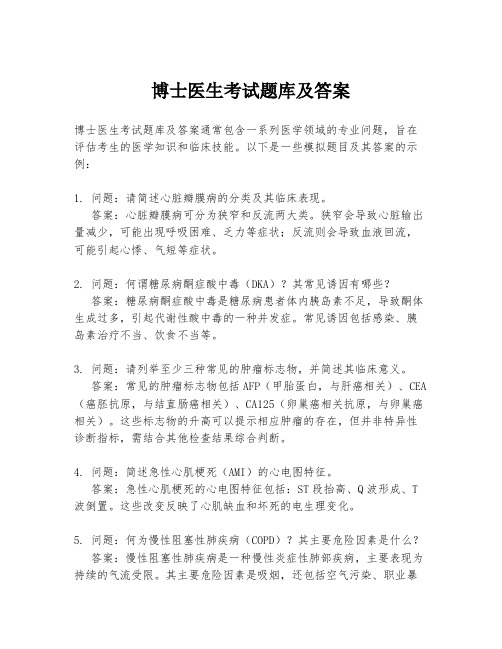
博士医生考试题库及答案博士医生考试题库及答案通常包含一系列医学领域的专业问题,旨在评估考生的医学知识和临床技能。
以下是一些模拟题目及其答案的示例:1. 问题:请简述心脏瓣膜病的分类及其临床表现。
答案:心脏瓣膜病可分为狭窄和反流两大类。
狭窄会导致心脏输出量减少,可能出现呼吸困难、乏力等症状;反流则会导致血液回流,可能引起心悸、气短等症状。
2. 问题:何谓糖尿病酮症酸中毒(DKA)?其常见诱因有哪些?答案:糖尿病酮症酸中毒是糖尿病患者体内胰岛素不足,导致酮体生成过多,引起代谢性酸中毒的一种并发症。
常见诱因包括感染、胰岛素治疗不当、饮食不当等。
3. 问题:请列举至少三种常见的肿瘤标志物,并简述其临床意义。
答案:常见的肿瘤标志物包括AFP(甲胎蛋白,与肝癌相关)、CEA (癌胚抗原,与结直肠癌相关)、CA125(卵巢癌相关抗原,与卵巢癌相关)。
这些标志物的升高可以提示相应肿瘤的存在,但并非特异性诊断指标,需结合其他检查结果综合判断。
4. 问题:简述急性心肌梗死(AMI)的心电图特征。
答案:急性心肌梗死的心电图特征包括:ST段抬高、Q波形成、T 波倒置。
这些改变反映了心肌缺血和坏死的电生理变化。
5. 问题:何为慢性阻塞性肺疾病(COPD)?其主要危险因素是什么?答案:慢性阻塞性肺疾病是一种慢性炎症性肺部疾病,主要表现为持续的气流受限。
其主要危险因素是吸烟,还包括空气污染、职业暴露和遗传因素等。
6. 问题:请解释何为高血压危象,并描述其紧急处理措施。
答案:高血压危象是一种急性血压升高的情况,伴有靶器官损害的风险。
紧急处理措施包括立即给予降压药物、评估并处理可能的并发症、监测生命体征等。
7. 问题:何为免疫缺陷病?请列举至少两种常见的免疫缺陷病。
答案:免疫缺陷病是指由于免疫系统功能缺陷导致的疾病,可分为原发性和继发性。
常见的原发性免疫缺陷病包括X连锁无丙种球蛋白血症和严重联合免疫缺陷病。
8. 问题:请简述甲状腺功能亢进症的临床表现和治疗方法。
复旦大学医学部博士入学考试生物化学试题(历年真题)

复旦大学医学部博士入学考试生物化学试题(历年真题)
复旦大学医学部博士入学考试生物化学试题(第一套)
一、名词解释
1.核酶
2.中心法则
3.模序
4.操纵子
问答题(4个,每个15分)
1.举例说明蛋白质一级结构空间结构与功能的关系
2.举例说明竞争性抑制的定义及在实践中的应用
3.氨的来源和去路
4. 举例说明端粒和端粒酶的作用
复旦大学医学部博士入学考试生物化学试题(第二套)
一、名解4x10
1.质粒
2.转染
3.核酶
4.胆固醇逆向转运
5.核酸杂交
6.PCR
7.离子交换柱层析
8.蛋白质结构域
9.G蛋白
10.蛋白质变性
二、简答15x4
1.蛋白质分离的方法与原理
2.酶抑制剂的临床应用
3.基因工程的基本步骤和原理
4.蛋白质与核酸相互作用的机理和举例。
医学考博英语试题及答案
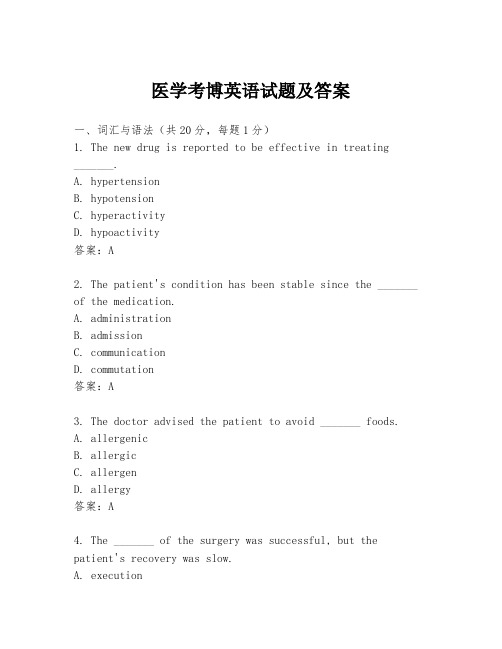
医学考博英语试题及答案一、词汇与语法(共20分,每题1分)1. The new drug is reported to be effective in treating_______.A. hypertensionB. hypotensionC. hyperactivityD. hypoactivity答案:A2. The patient's condition has been stable since the _______ of the medication.A. administrationB. admissionC. communicationD. commutation答案:A3. The doctor advised the patient to avoid _______ foods.A. allergenicB. allergicC. allergenD. allergy答案:A4. The _______ of the surgery was successful, but thepatient's recovery was slow.A. executionB. implementationC. performanceD. operation答案:D5. The _______ of the disease is influenced by genetic factors.A. progressionB. regressionC. transmissionD. transition答案:A二、阅读理解(共30分,每篇5分)Passage 1Recent studies have shown that a balanced diet can significantly reduce the risk of heart disease. Experts recommend consuming a variety of fruits and vegetables, whole grains, lean proteins, and healthy fats. It is also important to limit the intake of salt, sugar, and saturated fats.5. What is the main idea of the passage?A. The importance of a balanced dietB. The role of fruits and vegetables in heart healthC. The dangers of salt, sugar, and saturated fatsD. The benefits of lean proteins and healthy fats答案:A6. According to the passage, which of the following is NOT recommended for heart health?A. Consuming a variety of fruits and vegetablesB. Eating whole grainsC. Limiting the intake of salt and sugarD. Eating large amounts of saturated fats答案:DPassage 2The use of electronic health records (EHRs) has increased significantly in recent years. EHRs provide a comprehensive view of a patient's medical history, which can improve the quality of care. However, the implementation of EHRs also presents challenges, such as ensuring data privacy and security.7. What is the main advantage of EHRs mentioned in the passage?A. They provide a complete medical historyB. They improve patient-doctor communicationC. They reduce medical errorsD. They lower healthcare costs答案:A8. What challenge is associated with the use of EHRs?A. Ensuring data privacy and securityB. Training medical staff to use the systemC. Maintaining the hardware for the systemD. Complying with legal regulations答案:A三、完形填空(共20分,每题2分)In recent years, telemedicine has become increasingly popular as a means of providing medical care to patients in remoteareas. This approach allows doctors to consult with patients via video conference, 9. which can save both time and money. Telemedicine can also 10. provide access to specialized care that may not be available locally.9. A. therebyB. moreoverC. howeverD. otherwise答案:A10. A. potentiallyB. actuallyC. certainlyD. occasionally答案:A四、翻译(共30分,每题15分)将下列句子从英文翻译成中文。
各大名校历年考博真题及答案--呼吸内科部分

各⼤名校历年考博真题及答案--呼吸内科部分名词解释Horner综合征(北医2001):肺尖部肺癌⼜称肺上沟瘤,易压迫颈部交感神经,引起病侧眼睑下垂,瞳孔缩⼩,眼球内陷,同侧额部与胸壁少汗或⽆汗。
D-⼆聚体(复旦2003,哈医⼤2007):D-⼆聚体是纤维蛋⽩单体经活化因⼦XIII 交联后,再经纤溶酶⽔解所产⽣的⼀种特异性降解产物,是⼀个特异性的纤溶过程标记物。
D-⼆聚体来源于纤溶酶溶解的交联纤维蛋⽩凝块。
PE / PTE(同济2009):肺栓塞/肺⾎栓栓塞症肺栓塞(PE):是以各种栓⼦阻塞肺动脉系统为其发病原因的⼀组疾病或临床综合征的总称,包括PTE,脂肪栓塞综合征,空⽓栓塞等。
肺⾎栓栓塞症(PTE)为来⾃静脉系统或右⼼的⾎栓阻塞肺动脉或其分⽀所致的疾病,以肺循环和呼吸功能障碍为其主要临床和病理⽣理特征。
ALI/ARDS(同济2009)定义⼀ALI/ARDS是指发⽣于严重感染、休克、创伤及烧伤等⾮⼼源性疾病过程中,肺实质细胞损伤导致的以急性进⾏性低氧⾎症、呼吸窘迫为特征的临床综合征。
定义⼆:ALI是指机体遭受严重损伤出现以弥漫性肺泡⽑细⾎管膜为主要损伤部位,导致以肺⽔肿和微⼩肺不张为病理特征、呼吸窘迫和顽固性低氧⾎症为突出表现的全⾝炎症反应综合征。
ALI严重到⼀定程度,达到诊断标准时即为ARDS。
最新定义:ARDS是⼀种急性弥漫性炎症性肺损伤,导致肺⾎管通透性和肺重量增加,⽽肺含⽓组织减少。
临床主要表现为低氧⾎症,影像学双肺致密影,伴随混合静脉⾎氧合不⾜、⽣理性死腔增加以及肺顺应性降低。
急性期形态学主要特征为弥漫性肺泡损伤(如⽔肿、炎症、透明膜形成或出⾎)ⅠⅡ型呼吸衰竭(同济2000)Ⅰ型呼吸衰竭:即缺氧性呼吸衰竭,⾎⽓分析特点是PaO2<60mmHg,PaCO2降低或正常。
主要见于肺换⽓障碍疾病,如严重肺部感染性疾病,间质性肺疾病,急性肺栓塞。
Ⅱ型呼吸衰竭:即⾼碳酸性呼吸衰竭,⾎⽓分析特点是PaO2<60mmHg,同时伴有PaCO2>50 mmHg,系肺泡通⽓不⾜所致。
博士入学考试肿瘤学历年真题(北大复旦中大天医南医同济湘雅三四军医大)
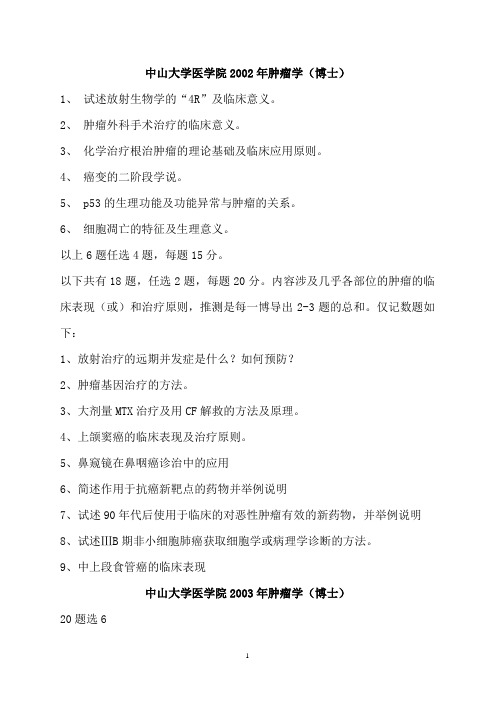
中山大学医学院2002年肿瘤学(博士)1、试述放射生物学的“4R”及临床意义。
2、肿瘤外科手术治疗的临床意义。
3、化学治疗根治肿瘤的理论基础及临床应用原则。
4、癌变的二阶段学说。
5、 p53的生理功能及功能异常与肿瘤的关系。
6、细胞凋亡的特征及生理意义。
以上6题任选4题,每题15分。
以下共有18题,任选2题,每题20分。
内容涉及几乎各部位的肿瘤的临床表现(或)和治疗原则,推测是每一博导出2-3题的总和。
仅记数题如下:1、放射治疗的远期并发症是什么?如何预防?2、肿瘤基因治疗的方法。
3、大剂量MTX治疗及用CF解救的方法及原理。
4、上颌窦癌的临床表现及治疗原则。
5、鼻窥镜在鼻咽癌诊治中的应用6、简述作用于抗癌新靶点的药物并举例说明7、试述90年代后使用于临床的对恶性肿瘤有效的新药物,并举例说明8、试述ⅢB期非小细胞肺癌获取细胞学或病理学诊断的方法。
9、中上段食管癌的临床表现中山大学医学院2003年肿瘤学(博士)20题选61、癌发生的二阶段学说2、基因突变的方式与原癌基因活化3、p53基因生物学特性与意义4、信号传导通路的组成5、调亡的特点及生物学意义6、肿瘤多步骤转移基本过程7、基因突变形式几检测方法8、化疗药物多药耐药性发生机制9、基因治疗策略10、腹部肿块的类型并举例11、说明胸部肺癌转移的各站淋巴结12、食道癌的X线表现13、四度白细胞减少患者合并严重感染的处理14、简述抗肿瘤药物的副作用及代表药物15、拓扑异构酶I和II的作用及区别,抑制剂的代表药物16、简述肿瘤外科在肿瘤治疗中的作用中山大学医学院2004年肿瘤学(博士)以下选答4条。
每条10分1、简述肿瘤外科在肿瘤综合治疗中的作用。
2、术前放疗的原则3、根治性化疗的理论基础和原则4、肿瘤免疫治疗有哪些方法?5、蒽环类最常见的副作用有哪些?如何防治?6、肿瘤细胞信号传导有哪些基本组成要素?7、信号转导的组成以下选3,各20分。
8、肺癌淋巴引流分组9、肿瘤外科发展趋势10、试述肿瘤的异型性11、Herceptin的原理、适应症及禁忌症12、什么是预防性手术,有哪些13、低恶性非霍奇金淋巴瘤治疗原则14、凋亡特征及发展机制15、中晚期胸上段食管癌的临床症状有哪些,为什么?16、AFP在肝癌诊治中的意义17、肝动脉栓塞化疗的原理18、基因突变有哪些及有哪些检查方法19、常见致癌因素及其致癌特点20、烃化剂作用机理,举出3种药物21、抗癌药物的不良反应有哪些,各举1例22、根治性颈淋巴洁清扫并发症有哪些,如何预防23、提高结肠癌疗效有哪些方法24、肿瘤局部,远处扩散机制25、鼻咽癌放疗后主要远期后遗症有哪些,哪些方法预防或减少发生肿瘤防治中心的临床型和科研型都是考此套试题。
复旦大学医学院病理学2005年考博真题试卷
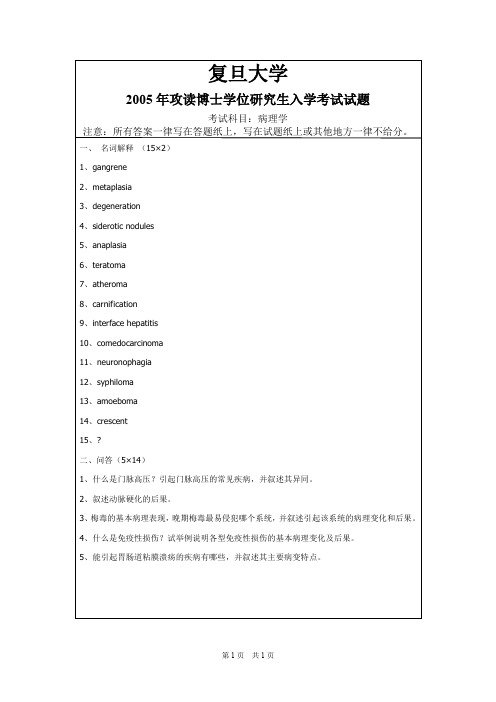
2005年攻读博士学位研究生入学考试试题
考试科目:病理学
注意:所有答案一律写在答题纸上,写在试题纸上或其他地方一律不给分。
一、名词解释(15×2)
1、gangrene
2、metaplasia
3、degeneration
4、siderotic nodules
5、anaplasia
6、teratoma
7、atheroma
8、carnification
9、interface hepatitis
10、comedocarcinoma
11、neuronophagia
12、syphiloma
13、amoeboma
14、crescent
ቤተ መጻሕፍቲ ባይዱ15、?
二、问答(5×14)
1、什么是门脉高压?引起门脉高压的常见疾病,并叙述其异同。
2、叙述动脉硬化的后果。
3、梅毒的基本病理表现,晚期梅毒最易侵犯哪个系统,并叙述引起该系统的病理变化和后果。
4、什么是免疫性损伤?试举例说明各型免疫性损伤的基本病理变化及后果。
5、能引起胃肠道粘膜溃疡的疾病有哪些,并叙述其主要病变特点。
复旦大学2000年临床检验诊断学考博真题
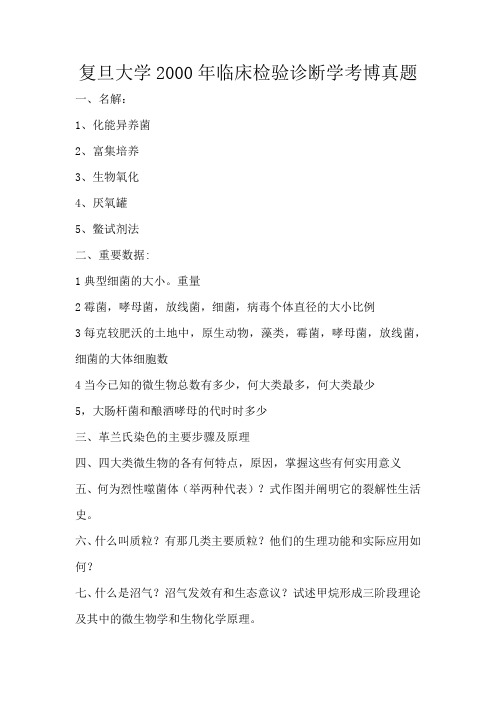
复旦大学2000年临床检验诊断学考博真题
一、名解:
1、化能异养菌
2、富集培养
3、生物氧化
4、厌氧罐
5、鳖试剂法
二、重要数据:
1典型细菌的大小。
重量
2霉菌,哮母菌,放线菌,细菌,病毒个体直径的大小比例
3每克较肥沃的土地中,原生动物,藻类,霉菌,哮母菌,放线菌,细菌的大体细胞数
4当今已知的微生物总数有多少,何大类最多,何大类最少
5,大肠杆菌和酿酒哮母的代时时多少
三、革兰氏染色的主要步骤及原理
四、四大类微生物的各有何特点,原因,掌握这些有何实用意义
五、何为烈性噬菌体(举两种代表)?式作图并阐明它的裂解性生活史。
六、什么叫质粒?有那几类主要质粒?他们的生理功能和实际应用如何?
七、什么是沼气?沼气发效有和生态意议?试述甲烷形成三阶段理论及其中的微生物学和生物化学原理。
八、什么是补体结合试验?它有何优点?试图示并说明其作用原理。
九、试写出以下五种微生物的学名(不可简写)
一种肠道细菌一种芽孢杆菌一种厌氧细菌一种酒精发酵菌一种重要工业霉菌。
骨科各校考博真题
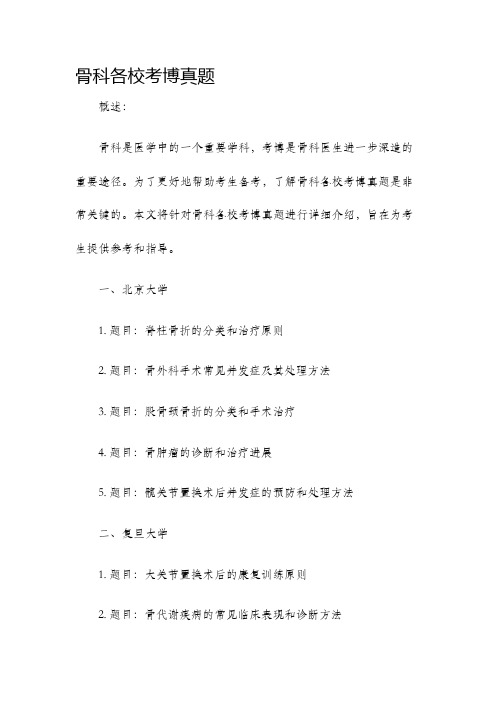
骨科各校考博真题概述:骨科是医学中的一个重要学科,考博是骨科医生进一步深造的重要途径。
为了更好地帮助考生备考,了解骨科各校考博真题是非常关键的。
本文将针对骨科各校考博真题进行详细介绍,旨在为考生提供参考和指导。
一、北京大学1. 题目:脊柱骨折的分类和治疗原则2. 题目:骨外科手术常见并发症及其处理方法3. 题目:股骨颈骨折的分类和手术治疗4. 题目:骨肿瘤的诊断和治疗进展5. 题目:髋关节置换术后并发症的预防和处理方法二、复旦大学1. 题目:大关节置换术后的康复训练原则2. 题目:骨代谢疾病的常见临床表现和诊断方法3. 题目:关节镜在骨科疾病中的应用和发展趋势4. 题目:肩袖断裂的病因和治疗方案5. 题目:骨关节炎的分型和保守治疗方法三、上海交通大学1. 题目:关节镜下前交叉韧带重建术的手术步骤及注意事项2. 题目:骨折愈合的影响因素及改善方法3. 题目:颅骨外伤的危险因素和治疗原则4. 题目:骨质疏松的预防和治疗策略5. 题目:膝关节置换术的适应症和手术技巧四、中山大学1. 题目:创伤性颈椎骨折的急救处理方法2. 题目:髋关节镜检查的操作步骤和要点3. 题目:股骨头坏死的诊断和分期方法4. 题目:脊柱侧弯的病因和治疗原则5. 题目:骨质疏松性骨折的诊断和治疗进展总结:了解骨科各校考博真题对考生备考具有重要意义。
不同学校的考试内容涵盖了骨科的各个方面,包括骨折分类和治疗原则、手术并发症处理、骨肿瘤的诊断和治疗、关节置换术后康复、骨关节炎的治疗等。
考生可以结合真题进行针对性的复习,提高备考效果。
在备考过程中,建议考生多做题、多练习,熟悉各个学校的考题风格,加强知识点的掌握,提高解题能力。
同时,考生也应该关注骨科领域的最新进展,了解最新的研究成果和临床应用,为考试做好充分准备。
最后,祝愿所有考生取得优异成绩,顺利进入理想的骨科医学研究领域!。
复旦大学医学院历年外科学考博、转博试题!

一、名词解释ARF、CVP、LC、MODS、MIDCAB、Rovsing征、Cullen征、Paget病、Richter疝、Litter疝、Calot三角、Crohn病、Heister(螺旋)瓣、Hesselbach(腹股沟)三角、Reynold 五联征、Mirrizzi综合征、Roux-en-Y吻合方式、AOSC的中外文全称、TIL的中英文全称、SIRS的中英文全称、ESWL体外冲击波碎石术的中外文全称、母细胞瘤、腹白线、气性坏疽、脑震荡、肛瘘、股疝、第二肝门、脓性指头炎、滑动疝、旋后肌综合症、低钙血症的两个体征、阴离子间隙、混合痔、交界痣、第一肝门、丹毒、肿瘤的三级预防二、问答1.血容量不足与急性肾衰的鉴别(列表)2.真菌性休克3.以胃癌为例说明肿瘤根治手术4.胰头癌合并黄疸的处理方案5.颈椎病的分类6.前列腺癌的诊疗进展7.酸碱平衡的调节途径8.脊柱结核的临床表现,诊断和处理(必须包括病灶清除术)9.感染性休克的临床表现和治疗10.肾损伤的分型和治疗11.乳腺癌的诊治进展12.膀胱癌的分期及治疗原则13.胸腺瘤的诊断,鉴别诊断,治疗及手术入路14.骨间后神经嵌压综合征的病因,临床表现,诊断及治疗15.急性重症胰腺炎的发病原因,机理,诊断,临床表现,治疗等方面的最新进展16.肝脏的分区及常用肝功能检测指标的临床意义17.超级性移植物排异反应的临床表现,发病原因,病理改变18.ARDS的临床表现,诊断依据,诊断标准19.肱骨髁上骨折的诊治原则20.皮质醇增多症21.食道癌手术径路22.代谢性碱中毒的血气改变23.溃疡手术治疗机理24.休克肾病理改变25.神经母细胞瘤的分级及治疗进展26.肾移植免疫药物的应用27.脊柱内固定的治疗进展28.高渗脱水的分类及治疗29.DIC的诊断30.脊柱侧凸的分类,测量及X线判断病变是否稳定31.血运性肠梗阻的病因,表现及治疗32.阻塞性黄疸的鉴别,治疗33.低钙血症的病因,表现,治疗34.胆管癌的诊治进展35.骨肉瘤的临床及X线表现,分型及治疗进展36.门脉高压分流术的手术方式及疗效评价37.肿瘤的生物治疗38.高钾血症的病因,临床表现以及对机体的影响39.输血时过敏反应和变态反应的表现和处理40.胃癌根治的手术原则41.胆总管探查的指征,T型管的观察指标,拔管指征42.后尿道损伤的诊断和处理43.胸腔镜的指征44.微创手术在泌尿外科的应用45.枕骨大孔疝的临床表现46.低心排量综合征的定义及表现,诊治47.前尿道外渗的范围48.微创心脏外科的目前进展49.ARDS的分期50.儿茶酚胺症的分类和诊断51.升主动脉瘤的病因和手术治疗52.多发性骨折伴开放性骨折的急救原则与病情观察,高能量创伤骨折有哪些特征53.前列腺炎的分类和诊断二、考试心得1.外科总论在必答题中占居比例较大(30%),须好好复习,重点章节——水电解质酸碱平衡、休克及MODS等。
复旦大学2003年考博专业课试卷骨科学(考博升级版)
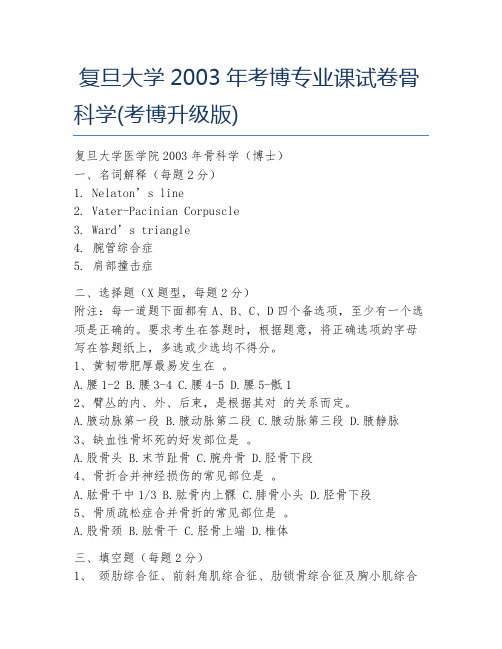
复旦大学2003年考博专业课试卷骨科学(考博升级版)复旦大学医学院2003年骨科学(博士)一、名词解释(每题2分)1. Nelaton’s line2. Vater-Pacinian Corpuscle3. Ward’s triangle4. 腕管综合症5. 肩部撞击症二、选择题(X题型,每题2分)附注:每一道题下面都有A、B、C、D四个备选项,至少有一个选项是正确的。
要求考生在答题时,根据题意,将正确选项的字母写在答题纸上,多选或少选均不得分。
1、黄韧带肥厚最易发生在。
A.腰1-2B.腰3-4C.腰4-5D.腰5-骶12、臂丛的内、外、后束,是根据其对的关系而定。
A.腋动脉第一段B.腋动脉第二段C.腋动脉第三段D.腋静脉3、缺血性骨坏死的好发部位是。
A.股骨头B.末节趾骨C.腕舟骨D.胫骨下段4、骨折合并神经损伤的常见部位是。
A.肱骨干中1/3B.肱骨内上髁C.腓骨小头D.胫骨下段5、骨质疏松症合并骨折的常见部位是。
A.股骨颈B.肱骨干C.胫骨上端D.椎体三、填空题(每题2分)1、颈肋综合征、前斜角肌综合征、肋锁骨综合征及胸小肌综合征等统称————,其最主要的症状是————受压迫的症状。
2、中国人脊髓圆锥下极位于————之间,其中位于————最多。
3、小儿骨科最常见的先天畸形是————和————。
4、臂丛上干损伤是由于————所致,损伤C5、C6神经之一部;臂丛下干损伤是由于————所致,通常损伤部位在C8、T1神经。
5、骨巨细胞瘤的好发部位是长骨的————,骨囊肿的好发部位是————。
四、简答题(任选4题,每题10分)1、简述髋关节解剖结构,髋关节后脱位的发病机理及复位手法。
2、试述尺神经的构成及运动感觉支配,以及腕部尺神经损伤后爪型手的形成机理。
3、简述保持膝关节稳定的主要结构及这些结构损伤时的临床表现。
4、简述血管损伤的病理类型。
5、试述肱骨内上髁骨折并尺神经损伤的手术显露途径及术中注意事项。
0复旦大学医学院肿瘤学(博士)
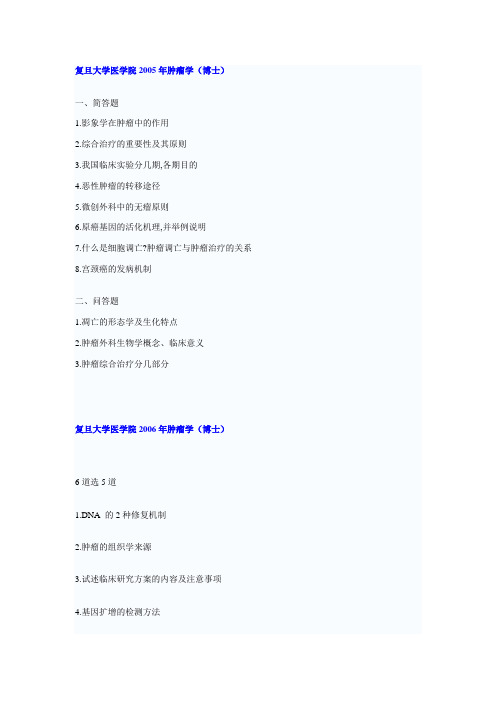
复旦大学医学院2005年肿瘤学(博士)
一、简答题
1.影象学在肿瘤中的作用
2.综合治疗的重要性及其原则
3.我国临床实验分几期,各期目的
4.恶性肿瘤的转移途径
5.微创外科中的无瘤原则
6.原癌基因的活化机理,并举例说明
7.什么是细胞调亡?肿瘤调亡与肿瘤治疗的关系
8.宫颈癌的发病机制
二、问答题
1.凋亡的形态学及生化特点
2.肿瘤外科生物学概念、临床意义
3.肿瘤综合治疗分几部分
复旦大学医学院2006年肿瘤学(博士)
6道选5道
1.DNA 的2种修复机制
2.肿瘤的组织学来源
3.试述临床研究方案的内容及注意事项
4.基因扩增的检测方法
5.防止肿瘤转移的治疗及方向
6.肿瘤和遗传相关性的2个方面。
协和、复旦、上医、同济、哈医等各大医科院校近年内科学考博真题集

2008武汉内科1名词解释A- S综合症LQTS心包摩擦音梗死后综合征高血压危象2简答AVRC病理特点劳力性心绞痛临床特点夜间阵法呼吸困难产生机制3论述主动脉狭窄主要症状及发生机制房颤射频消融治疗术式及其依据2007年重庆医科大学心内15分代谢综合症组织多普勒慢心衰细胞替代治疗85分为什么jnc-7指南非常强调收缩压的控制容栓适应症,禁忌症,再通指标CRT机制室性心律失常危险分级,治疗策略药物支架分类他丁类调脂药作用机理阿司匹林抵抗机理ACS治疗2008年重庆医科大学心内名词(5分每个)dddr austin flint杂音 bruganda syndrom eisenmenger syndrome 问答(10分每个)折返基本条件2001美国心衰abcd四期分类你的观点如何理解顽固性高血压crt定义和指征心源性晕厥包括那些疾病溶栓适应症和再通指标说说今年courage 临床试验和你的观点右心梗诊治2005年南方医心内科1.请简述肾素——血管紧张素系统2.请简述第二心音固定分裂的病理生理基础3.请简述心室舒张充盈受阻的病理生理基础4.请简述心源性休克的病理基础5.请简述环形运动折返的三个条件6.请描述心肌收缩和舒张的基本过程,并从而阐述心力衰竭发生的基本机制。
7.请描述酸中毒对心肌收缩力的影响。
8.临床对心力衰竭病人检测心率的基本意义是什么?9.休克早期病人通过什么途径代偿血压的下降?10.请区分SIRS、Sepsis和Septic shock的概念。
2008南方医科大学内科学试题(诊断+心血管病)一.诊断学部分:1.简答题:发热的临床过程及特点。
(8分)2.问答题:血压变化的临床意义。
(20分)二.心内部分:简答题:1.晕厥的原因。
(8分)2.心衰各阶段的治疗。
(8分)3.室上性心动过速的治疗。
(8分)4.二尖瓣狭窄的体征。
(8分)问答题:1.高血压治疗策略进展(05中国指南,07欧洲指南)。
(20分)2.图示ACS的评估和治疗流程。
复旦大学病理生理学历年真题

复旦大学上海医学院1999年病生试题复旦大学上海医学院2000年病生试题复旦大学上海医学院2001年病生试题复旦大学上海医学院2002年病生试题复旦大学上海医学院2003年病生试题复旦大学上海医学院2003年病生试题(博士) 复旦大学上海医学院2004年病生试题复旦大学上海医学院2005年病生试题复旦大学上海医学院1999年病生试题{一、名词解释1.低渗性脱水2.高钠血症3.慢性肾衰4.应激5.矫枉失衡学说6.酸透析7.单纯速发性MSOF二、简答1.右心衰时呼吸困难为何减轻?2.向心性心肌肥大机制3.儿茶酚胺导致再灌注损伤的机制三、问答1.休克产生自由基的途径?2.诊断酸碱平衡紊乱的论据?}复旦大学上海医学院2000年病生试题{一、名词解释1.渗出2.菌群移位3.低张性缺氧4.混合性酸碱紊乱5.自由基二、疾病的过程、DIC的发生三、呼吸衰竭的酸碱平衡失调的类型四.慢性肾衰的发病机制}复旦大学上海医学院2001年病生试题{一、名词解释(20分)1.内生致热源2.脑水肿3.缺血再灌注损伤4.血液性缺氧5.休克微循环淤滞期二、简答题(30分)1.简述非少尿性急性肾功能衰竭2.简述假性神经递质3.高肾性脱水有哪些特点?4.简述ARDS病人呼吸衰竭的主要机制5.判断脑死亡有哪些标准?三、问答题(50分)1.何谓矫枉失衡学说?请举例说明2.请叙述缺氧时肺血管收缩的机制3.代谢性酸中毒对机体有何影响?}复旦大学上海医学院2002年病生试题{一、名词解释1.呼吸衰竭2.非少尿型急性肾功能衰竭3.假性神经递质4.热限5.去极化阻滞二、问答题1.简述缺血再灌注时氧自由基生成增多的机制2.简述ARDS病人呼吸衰竭的主要机制3.慢性肾功能衰竭患者在纠正酸中毒后为什么会发生手足抽搐?4.引起乏氧性缺氧的原因有哪些?5.简述高动力型休克的可能机制?6.高渗性脱水有哪些特点?7.为什么治疗肝性脑病患者可以口服乳果糖?8.多系统器官衰竭患者肠道细菌和内毒素进入体循环的条件是什么?} 复旦大学上海医学院2003年病生试题{一、名词解释1.HIP2.LP3.uremic4.encephalopathy5.DIC6.钙反常7.呼吸衰竭8.肝性脑病9.健全肾单位学说10.多系统器官衰竭二、问答1.休克早期和休克期微循环特点的相同和不同2.氧自由基生成增多的机制3.心衰的神经体液代偿4.试述休克淤血期微循环淤滞的机制5.肥大的心肌为什么最终发生心力衰竭6.试比较肾病性水肿与肾炎性水肿发生机制的异同}复旦大学上海医学院2003年病生试题(博士){一、名词解释1.心肌重构2.盐水反应性碱中毒3.再灌注性心率失常4.caspases5.transuelate二、问答1.何谓肾性高血压,其机制如何?2.试述PTH;VitD3;降钙素与钙磷代谢的关系3.试述肝性脑病中血氨与氨基酸代谢的关系4.试述各种细胞信号转导途径的分布,组成以及相互关系,有何不同的联系?} 复旦大学上海医学院2004年病生试题{一、名词解释1.HIF-12.AP3.ERK4.LIBS5.a-MSH6.cARS7.ICAM-18.iNOS9.AG10.AQP二、问答1.肝性脑病的发病机理2.肝功能不全时物质代谢异常及机制3.何谓混合拮抗反应综合征,机制是什么?4.为何近几年多尿型肾衰病例明显增多?5.P53在调亡中的作用6.心脏舒张功能不全的机制}复旦大学上海医学院2005年病生试题{一、名词解释1.旁分泌2.肾小管性酸中毒3.浓缩性碱中毒4.交互通话5.核酸内切酶6.调亡指数7.组织因子途径抑制物8.CO2麻醉9.D-二聚体10.脂质过氧化损伤二、问答1.试述代谢性酸中毒时钙磷代谢变化2.血管内皮细胞在凝血、抗凝血和纤溶过程中的作用3.试述心力衰竭时的心外代偿4.肺泡通气和血流比例失调在呼吸衰竭发病中的作用5.基质金属蛋白酶与肝脏纤维化的关系}复旦大学上海医学院1999年病生试题{一、名词解释1.低渗性脱水2.高钠血症3.慢性肾衰4.应激5.矫枉失衡学说6.酸透析7.单纯速发性MSOF二、简答1.右心衰时呼吸困难为何减轻?2.向心性心肌肥大机制3.儿茶酚胺导致再灌注损伤的机制三、问答1.休克产生自由基的途径?2.诊断酸碱平衡紊乱的论据?}复旦大学上海医学院2000年病生试题{一、名词解释1.渗出2.菌群移位3.低张性缺氧4.混合性酸碱紊乱5.自由基二、疾病的过程、DIC的发生三、呼吸衰竭的酸碱平衡失调的类型四.慢性肾衰的发病机制}复旦大学上海医学院2001年病生试题{一、名词解释(20分)1.内生致热源2.脑水肿3.缺血再灌注损伤4.血液性缺氧5.休克微循环淤滞期二、简答题(30分)1.简述非少尿性急性肾功能衰竭2.简述假性神经递质3.高肾性脱水有哪些特点?4.简述ARDS病人呼吸衰竭的主要机制5.判断脑死亡有哪些标准?三、问答题(50分)1.何谓矫枉失衡学说?请举例说明2.请叙述缺氧时肺血管收缩的机制3.代谢性酸中毒对机体有何影响?}复旦大学上海医学院2002年病生试题{一、名词解释1.呼吸衰竭2.非少尿型急性肾功能衰竭3.假性神经递质4.热限5.去极化阻滞二、问答题1.简述缺血再灌注时氧自由基生成增多的机制2.简述ARDS病人呼吸衰竭的主要机制3.慢性肾功能衰竭患者在纠正酸中毒后为什么会发生手足抽搐?4.引起乏氧性缺氧的原因有哪些?5.简述高动力型休克的可能机制?6.高渗性脱水有哪些特点?7.为什么治疗肝性脑病患者可以口服乳果糖?8.多系统器官衰竭患者肠道细菌和内毒素进入体循环的条件是什么?}复旦大学上海医学院2003年病生试题{一、名词解释1.HIP2.LP3.uremic4.encephalopathy5.DIC6.钙反常7.呼吸衰竭8.肝性脑病9.健全肾单位学说10.多系统器官衰竭二、问答1.休克早期和休克期微循环特点的相同和不同2.氧自由基生成增多的机制3.心衰的神经体液代偿4.试述休克淤血期微循环淤滞的机制5.肥大的心肌为什么最终发生心力衰竭6.试比较肾病性水肿与肾炎性水肿发生机制的异同}复旦大学上海医学院2003年病生试题(博士){一、名词解释1.心肌重构2.盐水反应性碱中毒3.再灌注性心率失常4.caspases5.transuelate二、问答1.何谓肾性高血压,其机制如何?2.试述PTH;VitD3;降钙素与钙磷代谢的关系3.试述肝性脑病中血氨与氨基酸代谢的关系4.试述各种细胞信号转导途径的分布,组成以及相互关系,有何不同的联系?} 复旦大学上海医学院2004年病生试题{一、名词解释1.HIF-12.AP3.ERK4.LIBS5.a-MSH6.cARS7.ICAM-18.iNOS9.AG10.AQP二、问答1.肝性脑病的发病机理2.肝功能不全时物质代谢异常及机制3.何谓混合拮抗反应综合征,机制是什么?4.为何近几年多尿型肾衰病例明显增多?5.P53在调亡中的作用6.心脏舒张功能不全的机制}复旦大学上海医学院2005年病生试题{一、名词解释1.旁分泌2.肾小管性酸中毒3.浓缩性碱中毒4.交互通话5.核酸内切酶6.调亡指数7.组织因子途径抑制物8.CO2麻醉9.D-二聚体10.脂质过氧化损伤二、问答1.试述代谢性酸中毒时钙磷代谢变化2.血管内皮细胞在凝血、抗凝血和纤溶过程中的作用3.试述心力衰竭时的心外代偿4.肺泡通气和血流比例失调在呼吸衰竭发病中的作用5.基质金属蛋白酶与肝脏纤维化的关系}复旦大学上海医学院1999年病生试题{一、名词解释1.低渗性脱水2.高钠血症3.慢性肾衰4.应激5.矫枉失衡学说6.酸透析7.单纯速发性MSOF二、简答1.右心衰时呼吸困难为何减轻?2.向心性心肌肥大机制3.儿茶酚胺导致再灌注损伤的机制三、问答1.休克产生自由基的途径?2.诊断酸碱平衡紊乱的论据?}复旦大学上海医学院2000年病生试题{一、名词解释1.渗出2.菌群移位3.低张性缺氧4.混合性酸碱紊乱5.自由基二、疾病的过程、DIC的发生三、呼吸衰竭的酸碱平衡失调的类型四.慢性肾衰的发病机制}复旦大学上海医学院2001年病生试题{一、名词解释(20分)1.内生致热源2.脑水肿3.缺血再灌注损伤4.血液性缺氧5.休克微循环淤滞期二、简答题(30分)1.简述非少尿性急性肾功能衰竭2.简述假性神经递质3.高肾性脱水有哪些特点?4.简述ARDS病人呼吸衰竭的主要机制5.判断脑死亡有哪些标准?三、问答题(50分)1.何谓矫枉失衡学说?请举例说明2.请叙述缺氧时肺血管收缩的机制3.代谢性酸中毒对机体有何影响?}复旦大学上海医学院2002年病生试题{一、名词解释1.呼吸衰竭2.非少尿型急性肾功能衰竭3.假性神经递质4.热限5.去极化阻滞二、问答题1.简述缺血再灌注时氧自由基生成增多的机制2.简述ARDS病人呼吸衰竭的主要机制3.慢性肾功能衰竭患者在纠正酸中毒后为什么会发生手足抽搐?4.引起乏氧性缺氧的原因有哪些?5.简述高动力型休克的可能机制?6.高渗性脱水有哪些特点?7.为什么治疗肝性脑病患者可以口服乳果糖?8.多系统器官衰竭患者肠道细菌和内毒素进入体循环的条件是什么?} 复旦大学上海医学院2003年病生试题{一、名词解释1.HIP2.LP3.uremic4.encephalopathy5.DIC6.钙反常7.呼吸衰竭8.肝性脑病9.健全肾单位学说10.多系统器官衰竭二、问答1.休克早期和休克期微循环特点的相同和不同2.氧自由基生成增多的机制3.心衰的神经体液代偿4.试述休克淤血期微循环淤滞的机制5.肥大的心肌为什么最终发生心力衰竭6.试比较肾病性水肿与肾炎性水肿发生机制的异同}复旦大学上海医学院2003年病生试题(博士){一、名词解释1.心肌重构2.盐水反应性碱中毒3.再灌注性心率失常4.caspases5.transuelate二、问答1.何谓肾性高血压,其机制如何?2.试述PTH;VitD3;降钙素与钙磷代谢的关系3.试述肝性脑病中血氨与氨基酸代谢的关系4.试述各种细胞信号转导途径的分布,组成以及相互关系,有何不同的联系?} 复旦大学上海医学院2004年病生试题{一、名词解释1.HIF-12.AP3.ERK4.LIBS5.a-MSH6.cARS7.ICAM-18.iNOS9.AG10.AQP二、问答1.肝性脑病的发病机理2.肝功能不全时物质代谢异常及机制3.何谓混合拮抗反应综合征,机制是什么?4.为何近几年多尿型肾衰病例明显增多?5.P53在调亡中的作用6.心脏舒张功能不全的机制}复旦大学上海医学院2005年病生试题一、名词解释1.旁分泌2.肾小管性酸中毒3.浓缩性碱中毒4.交互通话5.核酸内切酶6.调亡指数7.组织因子途径抑制物8.CO2麻醉9.D-二聚体10.脂质过氧化损伤二、问答1.试述代谢性酸中毒时钙磷代谢变化2.血管内皮细胞在凝血、抗凝血和纤溶过程中的作用3.试述心力衰竭时的心外代偿4.肺泡通气和血流比例失调在呼吸衰竭发病中的作用5.基质金属蛋白酶与肝脏纤维化的关系精品感谢下载!欢迎您的下载,资料仅供参考感谢下载载。
复旦大学医学院考博试题
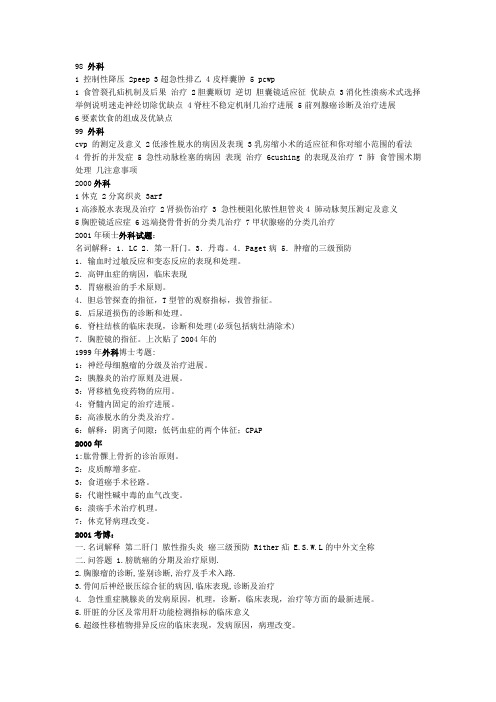
98 外科1 控制性降压 2peep 3超急性排乙 4皮样囊肿 5 pcwp1 食管裂孔疝机制及后果治疗 2胆囊顺切逆切胆囊镜适应征优缺点 3消化性溃疡术式选择举例说明迷走神经切除优缺点 4脊柱不稳定机制几治疗进展 5前列腺癌诊断及治疗进展6要素饮食的组成及优缺点99 外科cvp 的测定及意义 2低渗性脱水的病因及表现 3乳房缩小术的适应征和你对缩小范围的看法4骨折的并发症 5急性动脉栓塞的病因表现治疗 6cushing 的表现及治疗 7 肺食管围术期处理几注意事项2000外科1休克 2分窝织炎 3arf1高渗脱水表现及治疗 2肾损伤治疗 3 急性梗阻化脓性胆管炎4 肺动脉契压测定及意义5胸腔镜适应症 6远端挠骨骨折的分类几治疗 7甲状腺癌的分类几治疗2001年硕士外科试题:名词解释:1.LC 2.第一肝门。
3.丹毒。
4.Paget病 5.肿瘤的三级预防1.输血时过敏反应和变态反应的表现和处理。
2.高钾血症的病因,临床表现3.胃癌根治的手术原则。
4.胆总管探查的指征,T型管的观察指标,拔管指征。
5.后尿道损伤的诊断和处理。
6.脊柱结核的临床表现,诊断和处理(必须包括病灶清除术)7.胸腔镜的指征。
上次贴了2004年的1999年外科博士考题:1:神经母细胞瘤的分级及治疗进展。
2:胰腺炎的治疗原则及进展。
3:肾移植免疫药物的应用。
4:脊髓内固定的治疗进展。
5:高渗脱水的分类及治疗。
6:解释:阴离子间隙;低钙血症的两个体征;CPAP2000年1:肱骨髁上骨折的诊治原则。
2:皮质醇增多症。
3:食道癌手术径路。
5:代谢性碱中毒的血气改变。
6:溃疡手术治疗机理。
7:休克肾病理改变。
2001考博:一.名词解释第二肝门脓性指头炎癌三级预防 Rither疝 E.S.W.L的中外文全称二.问答题 1.膀胱癌的分期及治疗原则.2.胸腺瘤的诊断,鉴别诊断,治疗及手术入路.3.骨间后神经嵌压综合征的病因,临床表现,诊断及治疗4. 急性重症胰腺炎的发病原因,机理,诊断,临床表现,治疗等方面的最新进展。
- 1、下载文档前请自行甄别文档内容的完整性,平台不提供额外的编辑、内容补充、找答案等附加服务。
- 2、"仅部分预览"的文档,不可在线预览部分如存在完整性等问题,可反馈申请退款(可完整预览的文档不适用该条件!)。
- 3、如文档侵犯您的权益,请联系客服反馈,我们会尽快为您处理(人工客服工作时间:9:00-18:30)。
2014年复旦大学医学院肿瘤学博士入学
一、名词解释(每题4分,共5题,20分)
1.Translational medicine
2.Epigenetics
3.Cancer pain
4.L-Q model
5.Oxygen enhancement ratio
二、问答题(第1-4题每题15分,第5题20分,共80分)
1.简述胃癌淋巴结分组(日本JGPG标准);
2.简述小细胞肺癌的维持治疗策略;
3.简述乳腺癌的分子分型及临床意义;
4.简述恶性肿瘤的特征;
5.论述VEGF信号通路的组成及靶向VEGF信号通路主要药物的临床应用
2013年复旦大学医学院肿瘤学博士入学
一.名解4*6
1.新辅助化疗
2.宫颈鳞状上皮内瘤变(CIN)楼下战友提醒
3. 磨玻璃样病变/结节
4.EBUS-TBNA
二.填空
写三种AFP升高的肿瘤()()();直肠癌术后化疗的指正()()
癌症发生与病毒:鼻咽癌()口腔癌()
三.判断
比较广,只记得第一题是关于伊马替尼的
四.单项选择
五.多项选择
涉及疾病的分期,化疗方案(CHOP),结直肠癌的高危因素,日本2010胃癌什么标准中D1指哪些淋巴结,内胚窦瘤,哪些不是非精原细胞癌的高危因素;TNM分期意义总体还是有难度的
六.简答8*2
1.良恶性肿瘤的鉴别
2.肝原发癌与转移癌的影像学鉴别其论述15*2
1.乳腺癌的术后辅助内科治疗,治疗方案和药物举例
2.什么是结肠癌同时性肝转移,异时性肝转移,治疗原则
2012年复旦大学医学院肿瘤外科博士入学(公共+腹外)
公共部分:
一. 名解
1.癌的启动
2.肿瘤促进剂
3.细胞分化
4.奢侈基因
5.单核苷酸多态性SNP
6.肿瘤的演进
7.肿瘤转移
8.肿瘤特异性抗原
9.信号传导 10.肿瘤细胞的永生性
二.简答
1.肿瘤血管与正常血管异常
2.遗传性肿瘤与散发肿瘤区别
3.肿瘤抗原出现的分子机制
4.癌基因按功能分类
5.化学预防剂的防癌机制
腹外部分
一.名解
1.ypTNM
2.CME
3.胃癌N3a期
4.AFP
5.前哨淋巴结微转移二.简答
1.结肠癌穿孔按病理和临床表现分哪三类型 2大肠癌可切除肝转移NCCN2012治疗策略 3.结肠癌2期高危因素 4.原发性肝癌的病理类型 5.胰头癌的表现
6.乳头溢液有哪些疾病
7.影像引导下乳腺肿块微创活检的注意事项 8.前哨淋巴结宏转移的意义和腋窝处理 9.早期胃癌的内镜表现
10.NCCN中国版胃癌手术原则
三.论述
1.预防吻合口瘘的关键因素
2.进展期胃癌综合治疗趋势
3.乳腺癌新辅助化疗的意义和注意事项
2012年复旦大学医学院肿瘤学博士入学试题:
1 增强CT的作用?
2 简述癌基因激活的方式
3 肿瘤多药耐药性及发生机制
4 简述与人类肿瘤有关的病毒并举例说明. 选答题:
1 肿瘤的三级预防
2 简述抗肿瘤的化学药物近期毒性及处理
3 食管癌的放疗原则
4 抗肿瘤新靶点药物
5 霍奇金和非霍奇金淋巴瘤的区别?
6 乳腺癌的放疗?
2011年复旦大学医学院肿瘤学博士入学试题回忆
1PET-CT 2 肉瘤样癌 3RECIST 4 肺隔离病
二判断三单项选择四不定项选择五填空,较多,记不清了,只要看过书,相对比较简单六简答:1 谈谈不同影像学检查在胃肿瘤诊断和分期中的作用 2 谈谈在临床工作中你如何解读病理报告七论述题 1 小细胞肺癌的综合治疗原则
2 如何鉴别以纵膈淋巴结肿大为特征的淋巴瘤、结节病及肺癌纵膈淋巴结转移
2010年复旦大学医学院肿瘤学博士入学试题
一、名词 3*10
1 gross tumor volume
2 IGRT
3 PSA
4 Gene therapy
5 HPV
6 Carcinoma in situ
7 SRS
8 SAD
9 Adoptive cellulor immunotherapy 10 Apoptosis
二简答 8*6
1 树突状细胞抗肿瘤的机制
2 与肿瘤侵袭有关的因素
3 细胞周期及对放疗敏感性
4 早期乳腺癌手术指征及放疗指征
5 各种肿瘤浸润的特点
6 食管癌放疗过程中的副反应及处理原则
三论述题 11*2
1 现代肿瘤放射治疗学的进展
2 乳腺癌治疗原则及内分泌治疗策略
2009年复旦大学医学院肿瘤学博士入学试题
1. 应用联合化疗药物的配伍原则(10分) 2 恶性肿瘤的分期及意义是什么(10分) 3 恶性肿瘤的特征有哪些(10分)
4 试以乳腺癌为例说明肿瘤外科治疗的原则(10分)
5 说明肿瘤的三级预防(20分)
6 什么是询证医学?其证据如何分级?(20分)
7 病例分析:患者,女性,65岁,体检发现右下肺一1.5cm结节,无吸烟史,既往有糖尿病史,血糖控制在8.0mmol/l。
请说明诊断思路及下一步措施。
(20分)
2008年复旦大学医学院肿瘤学博士入学试题
一、名词解释 1. SNPs 2. MDR
3. Vasculogenesis
4. Metaplasia
5. LET
6. 临床试验
7. 自噬
8. 细胞周期素 9. 染色体分析 10. 多学科综合分析
二、简答 1.干预试验 2. DNA损伤形式 3. RTK信号转导通路 4. 组学技术内容 5.抗肿瘤药物分类
三.论述题
1. 肿瘤转移的器官选择性主要因素
2. 机体非特异性抗肿瘤免疫机制内容
3. 防止肿瘤播散的无瘤原则
4. 分子靶向治疗的靶点及目前面临的挑战四.进展及病例分析
1. 非编码RNA基因与肿瘤关系研究
2. 患者男47岁,直肠癌,分析诊断分期以及治疗
2007年复旦大学医学院肿瘤学博士入学试题
一. 简答题(5分*6)
1. 何谓循环肿瘤细胞(CTC)?
2. 简述NSCLC癌患者检测EGFR基因突变的主要意义?
3. 何谓癌痛的爆发痛?
4. 三维适形放疗(3D-CRT)?
5. 亚临床病灶
6. 肿瘤转移放疗专业必答
二.简答题(7分*5)
1.简述乳腺癌术后放疗指征
2. 简述可测量病变实体瘤的近期疗效评价标准有哪些? 3.简述肺癌行局部放疗时可能出现的并发症有哪些? 4. 近距离放疗的特点? 5. 临床放疗剂量学四原则?
三.问答题
1. 从放疗的局部治疗角度论述放疗领域的新进展?(20分)
2.近年来,肿瘤的发病率总体持续升高,请谈谈您对这种现象的认识?(15分)化疗专业必答
二.简答题
1. Ⅱ期结肠癌患者术后需进行辅助化疗的高危因素?(7分)
2. 肿瘤生物治疗的概念及范畴。
(8分)
3. 胃癌化疗的现状、适应症及常用的方案?(8分)
4. 局限期小细胞肺癌的特点与治疗现状?(8分)
5. 原发性肝癌治疗选择的决定因素及分子靶向药物应用的现状?(8分)
6. 前列腺癌内分泌治疗的临床现状与不良反应?(8分)
7. 滤泡性淋巴瘤的国际预后指数有哪些?其治疗现状如何?(8分)
2005年复旦大学医学院肿瘤学博士入学试题
一. 简答题
1.影像学在肿瘤中的作用
2.综合治疗的重要性及其原则
3.我国临床实验分几期,各期目的
4.恶性肿瘤的转移途径
5.微创外科中的无瘤原则
6.原癌基因的活化机理,并举例说明
7.什么是细胞调亡?肿瘤调亡与肿瘤治疗的关系 8.宫颈癌的发病机制
二、问答题
1.凋亡的形态学及生化特点
2.肿瘤外科生物学概念、临床意义
3.肿瘤综合治疗分几部分
复旦大学医学院2006年博士肿瘤学
6道选5道
1.DNA 的2种修复机制
2.肿瘤的组织学来源
3.试述临床研究方案的内容及注意事项
4.基因扩增的检测方法
5.防止肿瘤转移的治疗及方向。
